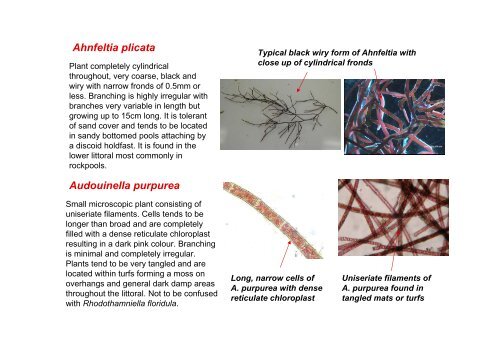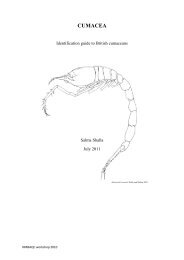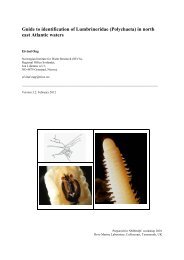s A Field Guide to the British Seaweeds - NMBAQC
s A Field Guide to the British Seaweeds - NMBAQC
s A Field Guide to the British Seaweeds - NMBAQC
You also want an ePaper? Increase the reach of your titles
YUMPU automatically turns print PDFs into web optimized ePapers that Google loves.
Ahnfeltia plicata<br />
Plant completely cylindrical<br />
throughout, very coarse, black and<br />
wiry with narrow fronds of 0.5mm or<br />
less. Branching is highly irregular with<br />
branches very variable in length but<br />
growing up <strong>to</strong> 15cm long. It is <strong>to</strong>lerant<br />
of sand cover and tends <strong>to</strong> be located<br />
in sandy bot<strong>to</strong>med pools attaching by<br />
a discoid holdfast. It is found in <strong>the</strong><br />
lower lit<strong>to</strong>ral most commonly in<br />
rockpools.<br />
Audouinella purpurea<br />
Small microscopic plant consisting of<br />
uniseriate filaments. Cells tends <strong>to</strong> be<br />
longer than broad and are completely<br />
filled with a dense reticulate chloroplast<br />
resulting in a dark pink colour. Branching<br />
is minimal and completely irregular.<br />
Plants tend <strong>to</strong> be very tangled and are<br />
located within turfs forming a moss on<br />
overhangs and general dark damp areas<br />
throughout <strong>the</strong> lit<strong>to</strong>ral. Not <strong>to</strong> be confused<br />
with Rhodothamniella floridula.<br />
Typical black wiry form of Ahnfeltia with<br />
close up of cylindrical fronds<br />
Long, narrow cells of<br />
A. purpurea with dense<br />
reticulate chloroplast<br />
Uniseriate filaments of<br />
A. purpurea found in<br />
tangled mats or turfs




